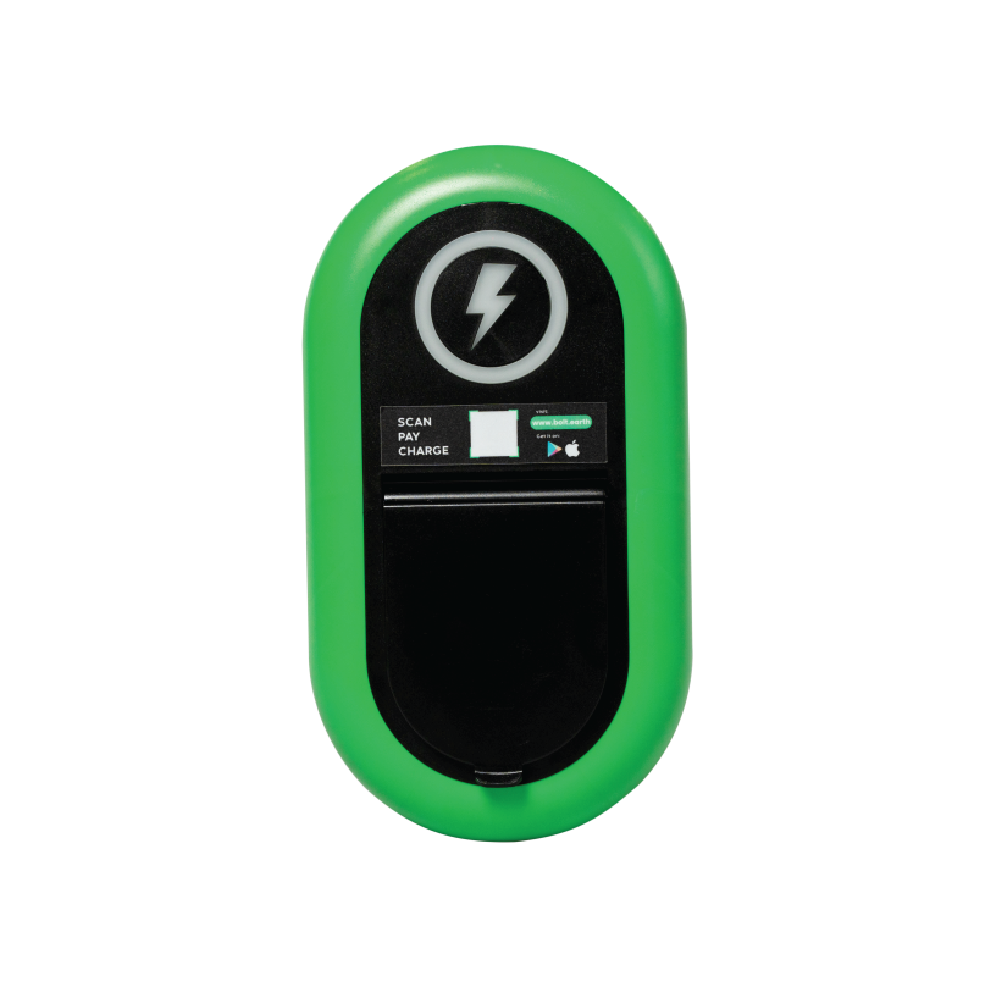Solar EV Charging in India: Why RWAs Must Lead the Transition
Raghav Bharadwaj
Chief Executive Officer
Published on:
14 Jun, 2023
Updated on:
23 Dec, 2025

For EV adoption in India to be truly sustainable, Resident Welfare Associations (RWAs) must embrace renewable energy. With an estimated annual generation potential of 5,000 trillion kWh per year and many regions getting 4-7 kWh/sq.m per day, India has a vast solar resource that can significantly contribute to making EVs more environmentally friendly, and RWAs can play a pivotal role in powering EVs cleanly and affordably.
By harnessing solar power from the sun through photovoltaic panels, solar charging systems allow EV owners to utilize renewable energy for charging their vehicles, thus reducing their dependence on the electrical grid and lowering their carbon footprint. More importantly, switching to renewable energy will eventually decrease the cost of charging, leading to increased EV adoption and improved return on investment for RWAs.
In light of such opportunities for RWAs to transition to clean energy, this article examines three key questions:
- What is the impact of solar charging systems on electric vehicles in terms of residential sustainability?
- Why should RWAs consider implementing solar charging systems for electric vehicles in residential areas?
- How can RWAs overcome the challenges associated with installing these systems to promote residential sustainability and facilitate a shift towards clean energy sources?
Solar Charging Adoption Among RWAs in India
India is the fourth largest producer of solar energy in the world, with a total installed solar capacity of 82 GW as of November 2025, up from 61.97 GW in 2022. Recent advancements in technology have made solar power a more practical and cost-effective choice, bringing its tariff on par with the traditional grid.
Though EV solar chargers are not widely adopted yet, they have caught the attention of some pioneering RWAs, and many housing societies have already taken advantage of available subsidies to go green. Currently, the Delhi government is encouraging local housing societies to install solar panels for residents. Some RWAs in Maharashtra have gone a step further, implementing solar panels specifically for EV charging.
To promote this trend and reap its many benefits, RWAs must tap into their abundant and competitively priced energy source for EV charging. By doing so, RWAs can reduce their cost of power generation, alleviate strain on the power grid, and optimize energy usage and efficiency. Overall, RWAs can contribute to a sustainable future while simultaneously enhancing their own financial prospects and improving the quality of life for their residents.
Environmental Impact of Solar Charging Systems
Given that 80 to 90% of EV owners charge at home, making solar integration crucial.
Typically, electricity generated from coal-based thermal power plants is responsible for a significant portion of harmful air pollutants, including particulate matter, sulfur dioxide, mercury, and nitrogen dioxide. The release of nitrogen dioxide from burning fossil fuels is estimated to cause around 350,000 new cases of childhood asthma each year in India. These air pollutants are also linked to adverse health effects like stroke, lung cancer, and asthma in adults.
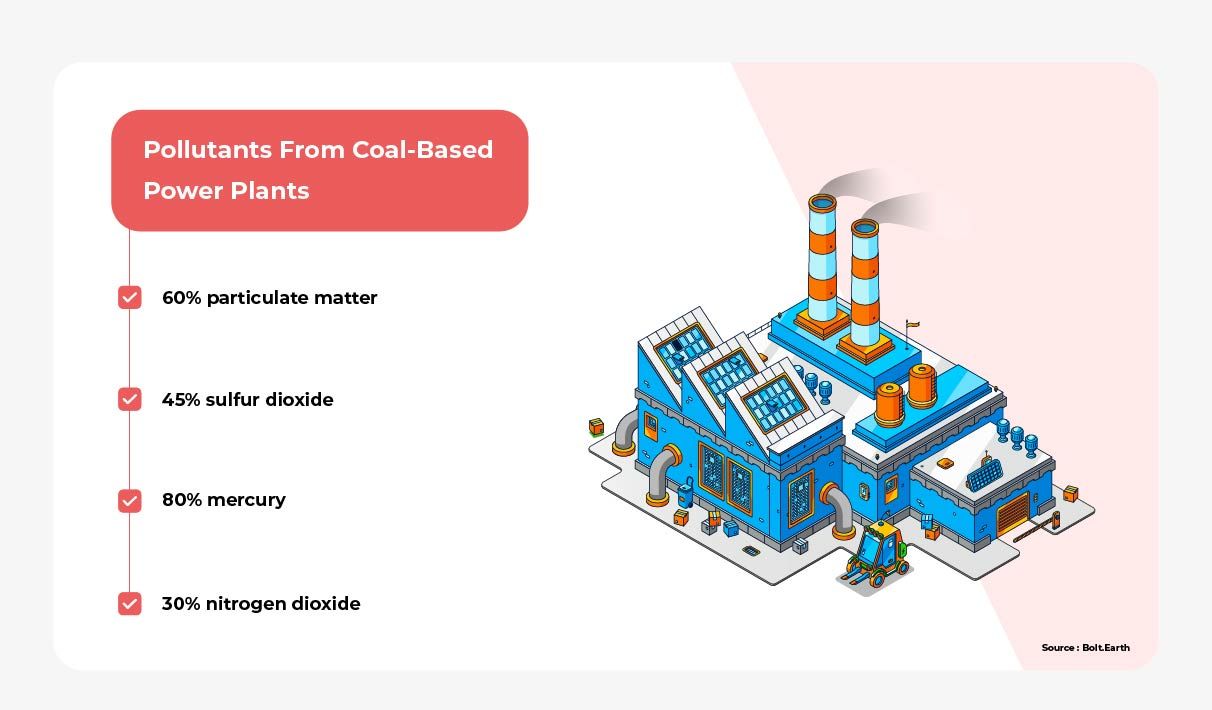
Additionally, fly ash produced as a byproduct of thermal power plants can contaminate local water sources. This ash contains toxic and heavy metals, leading to many diseases among the population and negatively impacting groundwater recharge. By reducing dependence on thermal power plants, RWAs can mitigate the impacts of fly ash – especially for housing communities located near or within the same city as these plants.
A wider EV adoption, if powered by fossil fuels, can worsen the environmental impact. Instead, RWAs can switch to solar charging systems to greatly negate these effects. In particular, solar EV charging is considered net zero, meaning it doesn’t add to the greenhouse gases that cause climate change. Moreover, using solar EV chargers can reduce air and water pollution in their communities, while also ensuring no negative impact on the groundwater. All these aspects can improve the quality of life of their residents and promote a healthier environment.
Economic Impact of Solar Charging Systems
Solar-powered charging stations offer a cost-effective solution for both RWAs and EV owners in India. With electric tariffs ranging from ₹4 to ₹7/kWh, powering an EV entirely with solar energy can drastically reduce costs. Even charging a modest fee of ₹1 to ₹2/ kWh can provide a steady revenue stream for RWAs. Also, RWAs have the opportunity to sell any unused solar power to the local DISCOM.
Though installing solar panels can be a large initial investment, it ultimately yields revenue for many years to come. Additionally, the Indian government offers a 40% subsidy for residential solar rooftop installations. RWAs can leverage this subsidy to bring down their installation costs significantly.
Together, these factors make EV solar charging infrastructure a potential avenue for RWAs to earn extra income over an extended period. By investing in solar infrastructure today, RWAs can benefit from available subsidies and achieve a high ROI.
To gain these economic and environmental benefits, RWAS need to familiarize themselves with the technical aspects of these solar charging systems.
Technical Aspects of Solar Charging Systems
Installing EV solar charging systems within housing communities involves several technical considerations. To begin, RWAs should understand the components involved in a solar charging system, including:
- Solar panels: These are the primary component that converts sunlight into electricity
- Battery storage systems: They store excess solar power generated during the day for use at night
- Charging stations: These connect the EV charger to the solar charging system and include an inverter for converting Direct Current (DC) generated from solar panels to Alternating Current (AC) for EV chargers
- Smart charging infrastructure: This software component enables load balancing, energy optimization, and real-time monitoring of the charging process
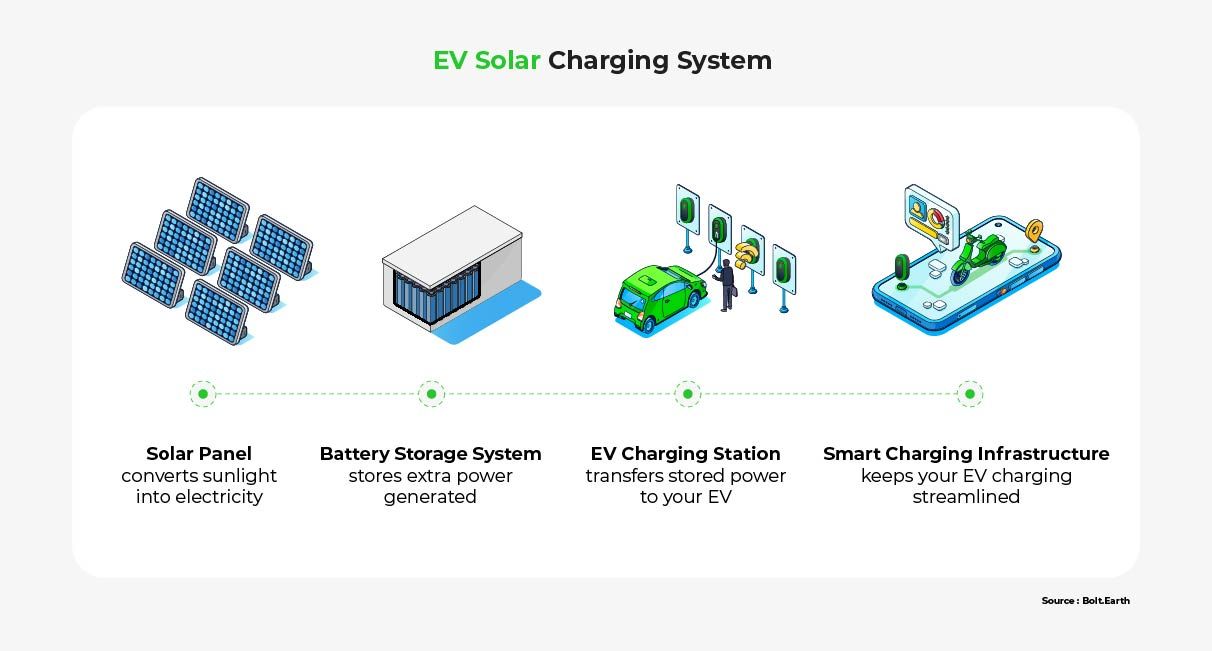
All four components are essential for the installation of an EV solar charging system. The capacity of solar panels and batteries needed depends on the usage of the housing community. RWAs must also decide whether to connect their solar power to the electricity grid. Integrating with the grid can provide RWAs the flexibility to draw power when solar power generation is low and feed excess power back into the grid for additional income. However, this integration involves coordination with local DISCOMs and may require associated permits and bureaucratic processes, leading to potential delays.
RWAs should also plan for regular monitoring and maintenance of the chargers. This includes panel cleaning, dedicated staff for monitoring usage, and establishing warranty agreements with OEMs. Seasonal variations and adverse weather can pose a challenge as well – RWAs should have a backup plan for EV charging during the monsoon months when solar power availability may be rare.
Knowing these aspects can better prepare RWAs to handle the challenges that come with installing solar charging infrastructure.
3 Challenges of EV Solar Charging Systems that Indian RWAs Face
Though solar charging systems offer many benefits for RWAs, their deployment poses three significant challenges – limited awareness and understanding of solar charging systems, high upfront costs and financing options, and a lack of charging infrastructure. By understanding the challenges associated with solar charging systems, RWAs can make informed decisions, mitigate risks, maximize benefits, and engage stakeholders most effectively.
1. Limited Awareness and Understanding of Solar Charging Systems
RWAs may not be able to garner the required support from residents, as volunteer office bearers often lack the necessary time and knowledge of the intricacies involved. This limited awareness can deter RWAs from installing solar systems for EV charging. Bridging this knowledge gap requires education about solar generation technology and a greater awareness of its benefits.
2. High Upfront Costs and Financing Options
The cost of installing solar panels depends on the area, required capacity, and budget. The solar rooftop calculator can provide an accurate cost of the installation. For example, to install 5kW capacity panels in Maharashtra, it can cost around ₹2,00,000. Even with a 40% subsidy, the costs can be prohibitive for small RWAs. Despite the low-cost financing options the government offers, it remains difficult for RWAs to install solar panels without support from their residents.
3. Lack of Charging Infrastructure
Many residential areas in India lack adequate and clear space for solar charging systems. Additionally, storing large amounts of solar power can be challenging due to nascent battery technology. Seasonal variations, especially during the monsoon months, can make solar power unreliable. RWAs must regularly clean and monitor solar panels to maintain their efficiency.
Addressing these challenges is critical for creating a clean and green cycle for EV usage and adoption.
3 Solutions that Prompt RWAs Towards Solar Charging Systems Adoption
Undoubtedly, solar panels are a cost-effective and green option for powering EV chargers. Finding innovative solutions is needed to realize the benefits of solar charging systems for Indian RWAs.
1. Education and Awareness Campaigns
- Create community campaigns to help residents understand the impact of EV charging with solar energy
- Tap into campaigns by governments and EV manufacturers that promote the use of solar charging
- Invite solar panel experts as guest speakers for events to discuss the benefits of solar for EV charging
- Foster collaboration and knowledge-sharing with neighboring RWAs
- Organize workshops and events to educate residents
- Utilize social media platforms to spread awareness
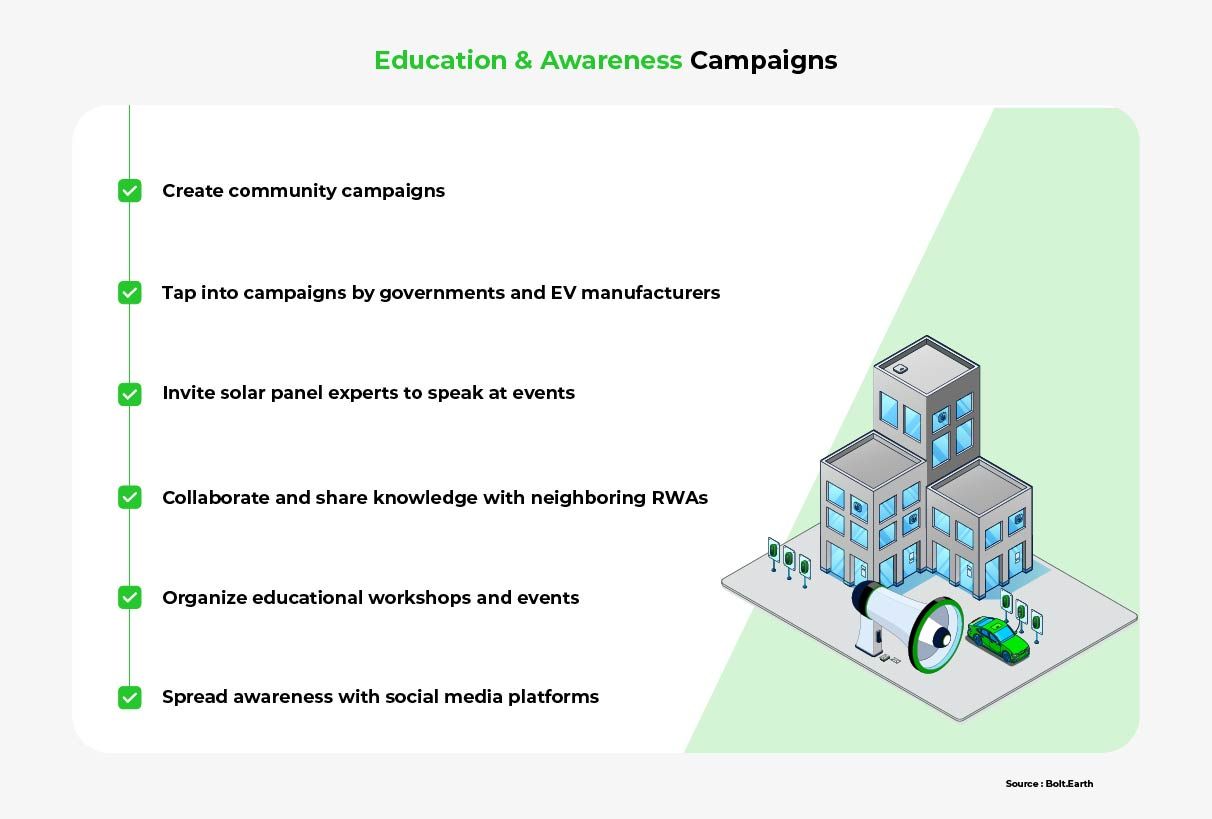
By advocating for EV solar charging infrastructure and showcasing its benefits, RWAs can make it feasible and accessible to their communities. These campaigns also generate support and interest from community members, which can attract investment.
2. Financing Options
- Estimate their requirements and the accurate installation costs
- Understand and leverage the subsidies offered by the central and state governments
- Utilize financing options provided by the central government
- Negotiate with vendors for monthly installments
- Crowdfund the costs from residents
- Collaborate with neighboring RWAs to share costs
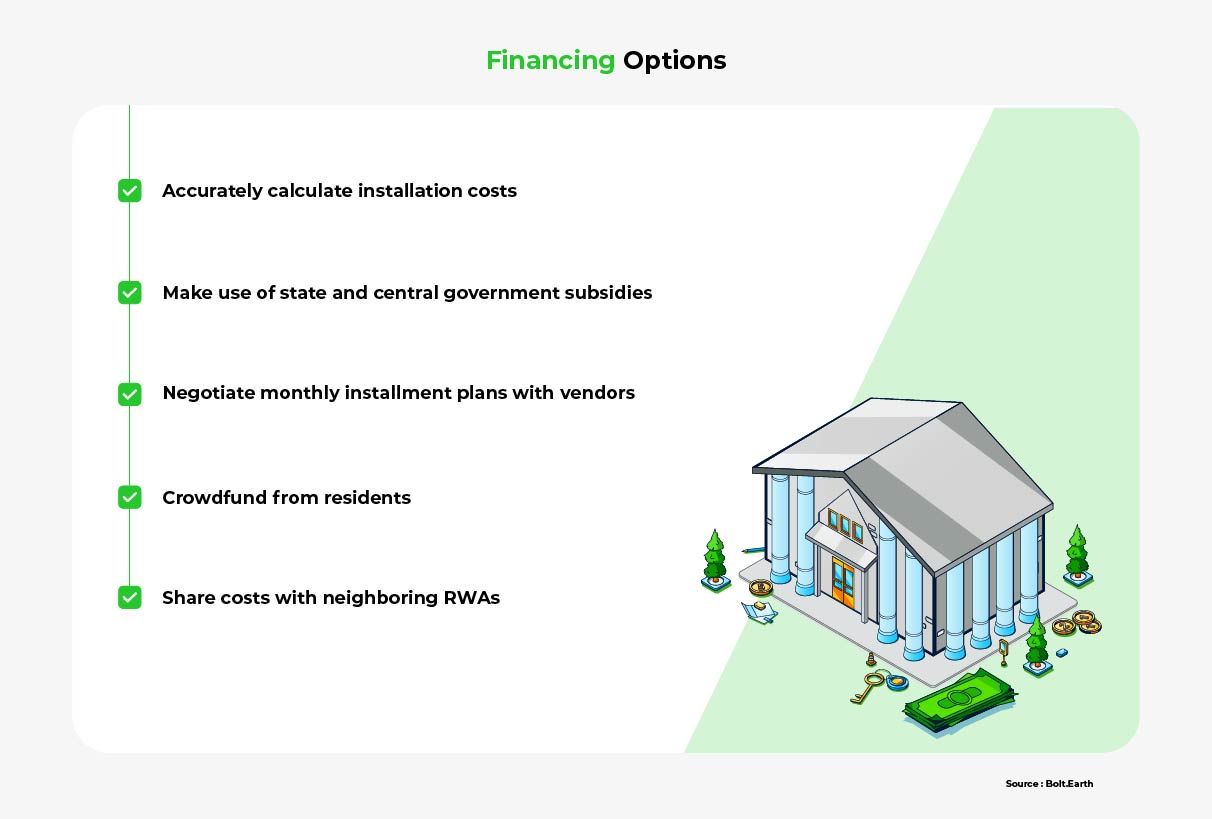
Financing options, when coupled with education and awareness campaigns, empower RWAs and community members to grasp the advantages of solar charging systems. By promoting these initiatives, there’s an increase in demand for charging infrastructure and, in turn, fostering collaboration among stakeholders. Consequently, this synergy paves the way for improved charging infrastructure development.
3. Charging Infrastructure Development
- Work with local governments to install solar panels in nearby open areas, with RWAs paying for the installation in exchange for free electricity equivalent to the generated solar power
- Collaborate with neighbors to install shared solar panels
- Engage residents in brainstorming ideas to use terraces and balconies for installing solar panels
- Consult with experts to understand how best to use the available space for solar installations
- Stay updated on technological advancements that reduce the space required for solar panels
- Consider repurposing unused space for solar panel installations

Promoting the adoption of EV charging with solar requires a multi-faceted approach to address the associated challenges. By implementing the above solutions, RWAs can take advantage of the benefits while laying the path for a sustainable future.
The Promising Role of EV Solar Charging Systems for RWAs
The future of solar EV systems in RWAs and residential communities in India is very promising. With the government’s push for electric mobility and renewable energy, solar EV systems are set to become more accessible and affordable. Adopting solar charging offers numerous environmental and economic benefits for RWAs and India. While challenges like a lack of awareness, high upfront costs, and inadequate charging infrastructure exist, RWAs can overcome them by collaborating with different entities. Spreading awareness through widespread campaigns, carefully planning and implementing suitable charging infrastructure, and leveraging low-cost financing options are important steps in the right direction.
As an RWA, you have the opportunity to be a pioneer. Take the initiative and embrace EV solar charging to create a brighter, cleaner, and greener future for your residents today.
This series has addressed different challenges that RWAs and housing communities face when it comes to installing EV charging infrastructure. Together, the four parts guide how RWAs can take the lead to boost EV adoption in India, enhancing property value, and offering added convenience for residents. By debunking myths and offering practical advice, this series equips RWAs with the knowledge and tools they need to make a lasting impact on their environment.

Frequently Asked Questions
What is a solar charging system for electric vehicles?
A solar charging system harnesses energy from the sun using solar panels and converts it into electricity to charge EVs. These solar panels generate DC power, which is then converted to AC power by the inverter and used to charge the EVs. This system usually consists of solar panels, a battery, a charging station that includes an inverter, and software for monitoring usage.
Does the government offer any incentives or subsidies for using solar charging systems for electric vehicles?
Yes, the government offers a subsidy of up to 40% of the total cost of solar installation. Additionally, RWAs can benefit from many tax incentives, like accelerated depreciation and exemption from customs duty and excise duty. These incentives aim to make solar charging systems more affordable and encourage their adoption to reduce carbon emissions and promote sustainable transportation.
Can solar charging systems completely replace traditional charging methods for electric vehicles?
No, solar charging systems cannot completely replace traditional charging methods for EVs. While solar charging systems offer a sustainable and renewable source of energy, they may not always provide enough power to fully charge an electric vehicle, especially during periods of low sunlight or high demand. Traditional charging methods, such as grid electricity or fast charging stations, may still be necessary for convenient and reliable charging.
Are solar charging systems cost-effective in the long run?
Yes, solar charging systems for EVs can be cost-effective in the long run. While the upfront installation costs of a solar charging system may be high, it can significantly reduce or eliminate the need for electricity from the grid, resulting in lower electricity bills in the long term. Additionally, solar charging systems require minimal maintenance and have a long lifespan, reducing overall costs.




